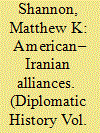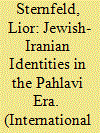|
|
|
Sort Order |
|
|
|
Items / Page
|
|
|
|
|
|
|
| Srl | Item |
| 1 |
ID:
140746


|
|
|
|
|
| Summary/Abstract |
The tension between “modernization” and “rights” defined the relationship between Americans and Iranians from the 1950s through the 1970s. The dynamic interplay between these two transnational currents is best understood through the lens of international education. U.S. policy makers envisaged Western-educated Iranians as the bastion of pro-Americanism required to provide the cultural underpinnings of the Washington–Tehran alliance. But the influx of Iranian students to American campuses globalized U.S. institutions of higher education and, in the process, produced an alternate alliance of Iranian youths and progressive Americans that rejected Shah Mohammad Reza Pahlavi’s authoritarian model of development, called for the realization of human rights in Iran, and revealed the contradictions inherent in a U.S. strategy that promoted student exchange while at the same time supporting the shah as an agent of modernization and anti-Communism.
|
|
|
|
|
|
|
|
|
|
|
|
|
|
|
|
| 2 |
ID:
191802


|
|
|
|
|
| Summary/Abstract |
Reza Shah’s attempt in the latter part of his autocracy (1935–1941) to implement formal education for the clergy continues to be one of the most understudied periods of Iran’s modern history. The primary aim of this paper is to investigate the ḥawza’s strategic response to Reza Shah’s envisaged secularism and to assess the contribution made by Ayatollah Muhammad Hojjat Kuh Kamari (1892–1952), the religious authority leading the ḥawza ʿilmīyya of Qum during this crucial phase. At a time, when the political establishment actively attempted to change the cultural identity of Iran through its promotion of modernization with Western connotations, he viewed this as a new challenge that endangered the Islamic fabric of Iranian society and placed an emphasis on a socio-cultural response by Shia clerics. By drawing on a range of primary sources not consulted before, this study aims at understanding how the institutional and intellectual development of this critical transition period led to the breathing period for ḥawza ʿilmīyya of Qum and the quasi-democratic phase of Iran (1941–1953). Additionally, this paper will analyse the approach of dynamic quietism that prioritized the engagement of the ‘ulamāʾ with education and society as the crucial factor in ensuring their socio-cultural influence in Iran.
|
|
|
|
|
|
|
|
|
|
|
|
|
|
|
|
| 3 |
ID:
184211


|
|
|
|
|
| Summary/Abstract |
In the 1960s and 1970s, Iranian officials embraced natural gas as a new energy source for their rapidly industrializing society, seeing it as a readily available substitute for the lucrative oil products their country's citizens were consuming in increasing amounts. Reacting to the growing concentrations of smoke and haze in cities, and unable to alter the mountainous terrain and semiarid climate that intensified them, gas seemingly promised to be a technical savior upon which to build an Iran as environmentally sound as it was prosperous, technologically sophisticated, and energy hungry. Pahlavi-era developmental choices were shaped by officials’ concern for deteriorating environmental conditions, the natural factors that compounded the issue, and the interests of private industry. Using archival and published materials collected in Iran, this article focuses on urban air pollution and the fitful efforts to mitigate it through the conversion of industrial facilities to gas.
|
|
|
|
|
|
|
|
|
|
|
|
|
|
|
|
| 4 |
ID:
133311


|
|
|
|
|
| Publication |
2014.
|
| Summary/Abstract |
A few years ago, while conducting archival research on Pahlavi-era Iranian newspapers, I came across a photo from the anti-shah demonstrations that took place in late 1978 and early 1979. It showed a large group of Armenians protesting against the shah. In these years many Iranians and Westerners considered the shah's policies beneficial for religious minorities in Iran. Around the same time, I found a sentence that made this discovery more intriguing. In his seminal work Iran between Two Revolutions, Ervand Abrahamian mentions that throughout the Muhammad Riza Pahlavi era, the opposition to the communist Tudeh party accused it of being controlled by "Armenians, Jews, and Caucasian émigrés." I tried to find references in the current scholarship to Jews participating in the party, which could have earned them their part in this propaganda campaign, but found very little. Having read the important works of Joel Beinin, Orit Bashkin, and Rami Ginat on Jewish revolutionaries, including communists, in the Middle East, I wondered where the Jewish radicals in Iran were. Several factors may contribute to this silence in the historiography: the writing of Iranian history from a Zionist vantage point, a lack of interest in the history of the Iranian left in the postrevolutionary historiography, and an inability to conceptualize the transregional and global nature of the Iranian Jewish community.
|
|
|
|
|
|
|
|
|
|
|
|
|
|
|
|
|
|
|
|
|